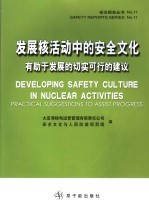
- 作 者:大亚湾核电运营管理有限责任公司安全文化与人因改进项目组译
- 出 版 社:北京:原子能出版社
- 出版年份:2006
- ISBN:750223585X
- 标注页数:133 页
- PDF页数:136 页
请阅读订购服务说明与试读!
订购服务说明
1、本站所有的书默认都是PDF格式,该格式图书只能阅读和打印,不能再次编辑。
2、除分上下册或者多册的情况下,一般PDF页数一定要大于标注页数才建议下单购买。【本资源136 ≥133页】
图书下载及付费说明
1、所有的电子图书为PDF格式,支持电脑、手机、平板等各类电子设备阅读;可以任意拷贝文件到不同的阅读设备里进行阅读。
2、电子图书在提交订单后一般半小时内处理完成,最晚48小时内处理完成。(非工作日购买会延迟)
3、所有的电子图书都是原书直接扫描方式制作而成。
1.1 Background 4
1.2 Objective 4
1.INTRODUCTION 4
1.3 Scope 6
1.4 Structure 8
2.SAFETY CULTURE 10
2.1 Concept of safety culture 10
2.2 General remarks about safety culture 10
3.STAGES OF DEVELOPMENT OF SAFETY CULTURE 16
3.1 Stage Ⅰ—Safety based solely on rules and regulations 16
3.2 Stage Ⅱ—Good safety performance becomes an organizational goal 18
3.3 Stage Ⅲ—Safety performance can always be improved 20
3.4 The three stages:conclusions 24
3.5 Linking practices to the development stages of safety culture 28
3.6 Influence of national culture 32
4.1.1 Vision 36
4.GENERAL PRACTICES TO DEVELOP ORGANIZATIONAL EFFECTIVENESS 36
4.1 Vision,mission,goals and values 36
4.1.2 Mission 38
4.1.3 Goals 38
4.1.4 Values 38
4.1.5 Process for developing and implementing vision,mission,goals and values 38
4.2 Facilitation/coaching 40
4.3 Openness 42
4.4 Teamwork 42
4.5 Continuous evolution of improved safety performance 44
5.SPECIFIC PRACTICES TO DEVELOP SAFETY CULTURE 46
5.1 Practices for senior management 46
5.2 Predictive measures to analyse risk 50
5.3 Errors as a learning opportunity 50
5.4 In depth analysis of events 52
5.5 Ability to learn 54
5.7 Employees' contribution to improving safety performance 56
5.6 The role of training in promoting a positive safety culture 56
5.7.1 Safety improvement teams 58
5.7.2 Safety committees and safety meetings 58
5.7.3 Safety conferences 58
5.8 Active involvement of contractors 60
5.9 Communication of safety issues to the public 60
5.10 Self-evaluation processes 62
5.11 Integrated safety evaluations 64
5.12 Safety performance indicators 66
5.13 Regulatory approach and implications for safety culture 66
5.14 Influence of the regulatory body 70
5.15 Interaction with regulators 72
6.ASSESSING PROGRESS IN THE DEVELOPMENT OF SAFETY CULTURE 74
6.1 Behavioural measures 74
6.2 Attitudinal measures 76
6.4 Overall assessment of safety culture 78
6.4.1 General evaluation model 78
6.3 Perception or belief measures 78
6.4.2 Specific organizational indicators of a progressive safety culture 80
7.DETECTION OF INCIPIENT WEAKNESSES IN SAFETY CULTURE 84
7.1 Symptoms of a weakened safety culture 84
7.1.1 Organizational issues 86
7.1.2 Regulatory issues 90
7.1.3 Employee issues 100
7.2 Revitalizing a weakened safety culture 106
7.1.4 Technology issues:plant conditions 106
8.CONCLUDING REMARKS 108
Appendix Ⅰ 110
Appendix Ⅱ 112
Appendix Ⅲ 114
Appendix Ⅳ 116
Appendix Ⅴ 124
REFERENCES 128
BIBLIOGRAPHY 129
CONTRIBUTORS TO DRAFTING AND REVIEW 130
